Business Articles - Money Management
Articles & Tips
Errors in estimating and contract language are easy to make but expensive to fix.
I've been a carpenter for 21 years and have had my own general contracting business for the last 16 years. Recently I completed a $65,000 project that included a kitchen remodel, plus the addition of new dining and breakfast rooms and a new garage. In most respects this job went well. The work progressed as planned and the workmanship of my carpenters and subcontractors was excellent. Best of all, the customers are quite happy with both the product and the experience. However, mistakes I made before the job started left me with far less profit than I had expected for three months of my work. How did this happen? The mistakes I made were of two basic types - errors in estimating and errors in contract writing. In this article, I'll explain each mistake, how much it cost, why I think it happened, and how I plan to avoid making the same error in the future.
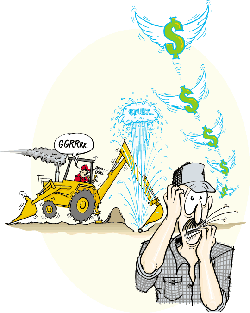
The biggest overrun - $335 for flooring - reflects the extra cost of blending new flooring into old. My sub's square-foot prices for flooring are usually pretty good, but in describing the job to him I made one little mistake: I told him that the new flooring could be installed the easy way - running alongside the existing flooring (see illustration, right). Had he visited the site, however, he would have noticed immediately that the flooring had to be installed the hard way. Weaving new strip flooring into the butt ends of existing boards involves a lot more work, and the sub charged accordingly.
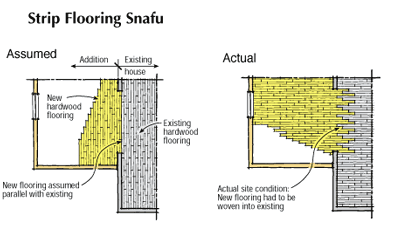
Altogether, I lost $513 on these three items. What's the lesson? I'd rather
keep taking phone quotes, especially on relatively small parts of a project,
because time will always be a factor in estimating. One solution is to add
money to phone quotes to allow for contingencies, even if extra work is not
apparent at the time of the project estimate. Actually, I did add a $400
contingency to the drywall bid of $2,354 on this project, to cover the extra
cost of various patching I knew would have to be done. As it turned out, the
drywall contractor didn't ask for anything extra, so I got to keep the $400.
This was not the result of good estimating, just good luck.
Tie-In Details
Elevations for house additions often show new areas of roofing or siding in
full detail; adjacent existing areas, however, appear as blank, undetailed
surfaces. While this technique clearly distinguishes new work from old, in
doing takeoffs it's easy to make the mistake of measuring only the new areas.
This ignores the fact that existing areas are almost always disturbed and must
be partially or completely redone.
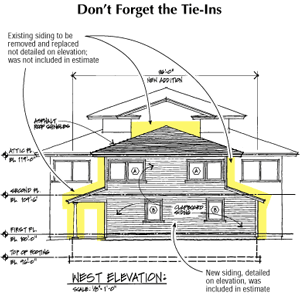
On this job, I failed to account adequately for this work, which included
roofing, siding, interior and exterior paint, gutters, flooring, and
baseboards. I'd guess that at least some of the $150 roofing overrun mentioned
above had to do with tying into the existing roof. My most serious failure in
this respect was with siding, where I completely missed several sizable areas
of existing siding that had to be removed and replaced to construct the
addition. We were able to avoid additional materials costs by reusing salvaged
siding. However, it took two carpenters nearly 16 man-hours to re-side these
areas. At an average cost of just over $18 per hour, this error cost me almost
$300.
This happened because I failed to take the time to really think through how
the work would be done. I was aware of the tie-in problem, but didn't foresee
the extent of the work it would require. .
Proxy Pricing
Another way I attempted to reduce the estimating time on this project was to use my own pricing for certain subcontract work, namely plumbing, gutters and downspouts, and excavation. I did pretty well with my plumbing estimate, which was low by only $46. And I was only off by $35 on my price for gutters and downspouts, which are billed to me by the linear foot, plus extra for unusual conditions. But I really blew it with the excavation estimate. I priced this work at $400, but the actual cost was $768 - almost twice what I had estimated.
How could I have mispriced this so badly? My notes reveal that I looked at actual excavation costs for two recent jobs of similar size; those jobs cost $310 and $240, so I figured $400 would be safe. This was not so, for three reasons: First, the current job was only accessible from the short side of the long, narrow rectangle that had to be excavated, requiring a lot more time to move excavated materials to the truck. On both of the earlier jobs, backhoe access was easy. The operator was able to approach the work from several angles, enabling him to remove material and load it into the dump truck quickly.
Second, the current site turned out to be a rat's nest of pipes and wires, requiring slow and careful work by the operator. Despite precautions, I still had to make several repairs. The two previous sites had been free of underground utilities in the work area. Third, the current job involved excavating for a driveway. It looked so small on the plans - about 12x18 feet - I figured the operator would excavate for it at the same time as the foundation. When construction started, however, it became clear that we would need the area where the new concrete driveway was to go as a work and storage area. This meant that the driveway excavation had to take place later on, adding a $65 move-in/move-out fee to the cost.
The cure for this problem is to have the excavator give me an estimate beforehand. They generally give me a number that will be safe, and since they charge me for actual time and materials, the final bill often comes in lower than their estimate. This gives me a nice cushion at the start of the job, which is much better than being in the hole - financially as well as physically - from day one. Had I asked the excavator to visit the site, the access problem would have been obvious to him. I could have caught the need to postpone the driveway excavation with more time and effort devoted to thinking about the sequencing of the work during estimating.
Optional Work
Part of this job involved having the gas company install a line to the house so the owners could install a gas range. The gas piping in the house was done by the heating contractor, who included an option to replace the existing electric water heater with a 50-gallon power-vented gas unit in his price. I didn't allow for this work in my base price, but I informed the owners that this work could be done for $940 - the amount my sub had quoted to me. I didn't discover my mistake until the owners decided to add this option. On top of the heating contractor's additional work, the plumber had to connect hot and cold water lines, and the electrician had to abandon a 240-volt supply line and install a 120-volt outlet for the power vent and condensate pump. I also incurred the cost of patching the siding around the power-vent flue outlet, and coordinating and supervising the extra work.
Luckily, I didn't pay the full price for this error. The owners were willing to accept a change order to pay for the plumber's work, and the extra electrical work got folded in with the rest of the job. I only lost about $50, but it could have been a lot worse.
The lesson here is that work included in options quoted by subcontractors actually has to be estimated as a separate small job. That's the only way to be sure that you get paid for all of the costs associated with optional work.
Labor
When I estimate labor for my own crew, I use historical records generated over
a number of years that tell me how long it usually takes to do certain tasks
that are common to most projects. For example, I know that under normal site
and weather conditions we'll be able to install 21/4 sheets of wall or roof
sheathing per hour. On this job, however, my siding price was too low. Some of
the overrun was caused by the tie-in problems mentioned above, but I also
underestimated overall siding labor by 15 hours, which cost me about $270.
Why was I under-priced? The truth is that I don't always believe my own historical numbers. Too often I will look at the labor figures and say to myself, The crew cannot possibly be that slow - there's no way it will really take this long So I'll cut some time off my man-hour estimate for whatever task I'm considering. I always regret doing this, but I continue to make this mistake. I think it's because I forget that my carpenters will be doing the work, not me. I forget that any speed I've gained from years of experience won't make any difference if I'm not on site.
Contingency Fund
After totaling costs for all materials, labor, and subcontractors, I normally
add 6% for contingencies. This is to cover the unexpected problems that always
occur in remodeling. These include inclement weather, an existing structure
that isn't plumb, level, or square, and paying subs to do work that I
inadvertently omitted from the original scope. I've almost always spent every
cent of my contingency fund.
On this job, a 6% contingency would have provided about $3,600, but I reduced the contingency to 4% or $2,400. I figured I wouldn't need the extra $1,200 because the 12-year-old house would present few problems. I was wrong. Although one would think that a new house would be reasonably level, the floor of the house was 7/8 inch out of level over the 24 feet where the addition tied in. This also affected the fascia we had to join at both ends of the addition. These are not insuperable problems for an experienced remodeler, but they do chew up time. More important, unless otherwise spelled out in the contract, the customer cannot be expected to pay extra for solving these kinds of problems.
The lesson here is that if a given level of contingency works over time, you should stick with it. All remodeling projects have unexpected problems and these problems eat up time, materials, and money.
Hidden Conditions
When I prepare a proposal, I choose from a list of standard contract clauses,
including those that apply to the particular job. One clause deals with buried
obstructions and says the following: "Underground Items: I will do my best
to avoid damaging underground utilities during the course of construction.
However, repairs to and/or rerouting of any such underground utilities will be
an extra charge." Since there's no way to be sure what is buried where on a
site, it's fair to charge extra for any repairs, providing you do your best to
avoid damage.
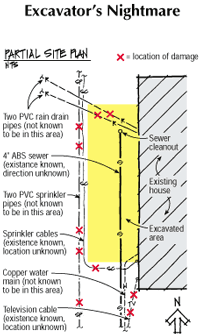
When we began excavating, we discovered that the side yard was full of buried pipes and wires (see illustration, above). We knew about the sanitary sewer and its cleanout, which would have to be relocated. We were also able, with great care, to avoid breaking the copper water main. Unfortunately, we were not so lucky with the PVC sprinkler pipes (broken in two places), the sprinkler control wires, the TV cable, or the rain drain from the existing house. Worse, when I checked the proposal for the underground utilities clause, I found that it was missing. Since there was no basis for a change order, I had to pay for the repairs myself. This included the TV cable and the sprinkler pipes, which were broken again later in the project. I calculate that all these repairs, in materials and time, amounted to $410 of work for which I wasn't paid.
Another clause I use covers unknown soil conditions: "Excavation: The contract price assumes that the earth to be removed will be undisturbed and will be removable with equipment typically used for projects of this size and nature. If additional work is required due to the presence of fill dirt, rock, underground water, buried septic or fuel tanks, or other unforeseen problems, such additional work will be an extra charge." As luck would have it, this house was located on a hillside. The addition was to be built on the downhill side, which had been leveled when the house was built. However, when the excavation was complete and the form work for the foundation was in place, the building inspector noticed that the front outside corner of the foundation was still resting on fill.
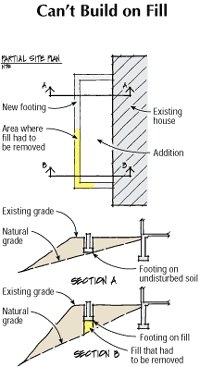
I was ordered to remove this down to the level of the natural slope. I ended up doing the work myself, but - you guessed it - the excavation clause was also missing from the proposal. This omission cost me $140 of my own time - 4 hours of backbreaking work with mattock and shovel on a hot summer afternoon.
Why were these contract clauses omitted? Prior to this job, my procedure was to take needed clauses from my standard form and transfer them to the proposal. Now, I insert the entire list of clauses into the proposal, then delete those that aren't needed for the particular project. I'd rather include unnecessary clauses that do no harm than omit necessary contract language. This systematic approach will tend to prevent errors that occur when impatience and mental dullness set in toward the end of a long bidding and contract-writing process.
Underlying Causes
Most of the mistakes I've discussed stem from two possible causes. The first
is the tendency to place production ahead of office work. When issues crop up
on site - and they do, every day - they need to be resolved immediately,
because workers are standing around waiting for answers. This makes it hard to
prepare estimates and contracts during working hours, when we tend to be at our
best mentally. The solution is a lead carpenter, system where a capable crew
can resolve most problems on its own or with a phone call to the office. This
lets the contractor spend concentrated, quality time in the office (see Working
Smarter with Lead Carpenters, 12/97).
The second problem is that, for most of us, estimating and contract writing
are tedious when compared with actual building. After all, few of us got into
building to be construction bureaucrats. The remedy here is a change in
attitude. Construction office work is a discipline, one that has to be acquired
and mastered in order to succeed as a contractor. Good discipline has its
rewards: On the job I've been discussing, a more thorough and careful job of
bidding and contract writing would have earned me many hundreds of dollars.
That's a very high rate of return on the hours invested.
by Al Coddington This article has been provided by www.jlconline.com. JLC-Online is produced by the editors and publishers of The Journal of Light Construction, a monthly magazine serving residential and light-commercial builders, remodelers, designers, and other trade professionals.
Join our Network
Connect with customers looking to do your most profitable projects in the areas you like to work.

